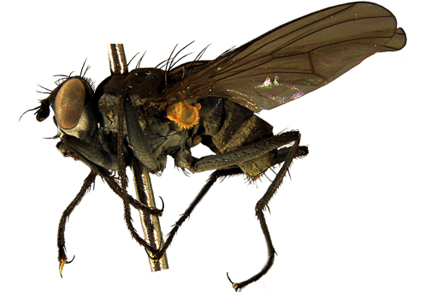Abstract
Xenomyia Malloch (Diptera, Muscidae) is a very interesting genus that includes predacious species with unusual combinations of characters. It is exclusively found in the Afrotropical region and currently comprises 16 species. The recent collection of the species Xenomyia hirtibasis (Bigot) in South Africa, has prompted this study, in which the species is redescribed, including, for the first time, the morphology of male and female terminalia, until now known only for Xenomyia natalensis Zielke (cercal plate and surstyli) and Xenomyia osculata Pont & Werner (male and female). Additionally, a key for the identification of all 16 species is provided, along with diagnoses for each species. Besides the original illustrations, we have gathered all available illustrations of the species from the literature, to facilitate the identification of them. Finally, we provide a map with the known geographical distribution of the species.
References
- Bigot, J.M.F. (1885) Diptères nouveaux ou peu connus. 25e partie. XXXIII. Anthomyzides nouvelles. Annales de la Société entomologique de France, 6 (4), 263–304.
- Crosskey, R.W. & Davies, J.B. (1962) Xenomyia oxycera Emden, a muscid predator on Simulium damnosum Theobald in Northern Nigeria. Proceedings of the Royal Entomological Society of London, Series A, 37, 22–26. https://doi.org/10.1111/j.1365-3032.1962.tb00283.x
- Couri, M.S. & Pont, A.C. (2020) Type specimens of Limnophorini (Diptera, Muscidae) deposited in the Museum für Naturkunde, Humboldt-Universität zu Berlin (Berlin, Germany). Zoologia, 37, 1–57. https://doi.org/10.3897/zoologia.37.e46879
- Cumming, J.M. & Wood, D.M. (2017) Adult morphology and terminology. In: Kirk-Spriggs, A.H. & Sinclair, B.J. (Eds), Manual of Afrotropical Diptera. Vol. 1. Introductory Chapters and Keys to Diptera Families. South African National Biodiversity Institute, Pretoria, pp. 89–133.
- Elsen, P. (1977) Note biologique sur Xenomyia oxycera Emden (Muscidae Limnophorinae) et Ochtera insularis Becker (Ephydridae), deux diptères prédateurs de Simulium damnosum Theobald (Diptera Simuliidae) en Côte d’Ivoire. Revue Zoologique Africaine, 91, 732–736.
- Emden, F.I. van (1943) Keys to the Muscidae of the Ethiopian Region: Phaonia-group. Annals and Magazine of Natural History, 11 (10), 73–10. https://doi.org/10.1080/03745481.1943.9727997
- Emden, F.I. van (1948) Entomological Expedition to Abyssinia, 1926–27. Diptera Cyclorrhapha: Muscidae, II. Annals and Magazine of Natural History, Series 11, 14, 460–484, 6 figs. https://doi.org/10.1080/03745481.1943.9727997
- Emden, F.I. van (1951) n.k. In: Muscidae: C. - Scatophaginae, Anthomyiinae, Lispinae, Fanniinae and Phaoniinae. Ruwenzori Expedition 1934–5. 2 (6). British Museum (Natural History), London, pp. 325–710, 106 figs, 3 tables.
- Gouteux, J.P. (1977) Observations morphologiques et écologiques sur les stades préimaginaux de Xenomyia oxycera Emden, 1951 (Muscidae Limnophorinae), diptère prédateur de Simulium damnosum s.l. (Diptera Simuliidae). Revue Zoologique Africaine, 91, 618–622.
- Hennig, W. (1965) Vorarbeiten zu einem phylogenetischen System der Muscidae (Diptera: Cyclorrhapha). Stuttgater Beiträge zur Naturkunde, 141, 1–100, 53 figs.
- Malloch, J.R. (1921) Exotic Muscaridae (Diptera). - I. Annals and Magazine of Natural History, Series 9, 7 (38), 161–173. https://doi.org/10.1080/00222932108632501
- Palmer, R.W. (1997) Principles of integrated control of blackflies (Diptera: Simuliidae) in South Africa. Report to the Water Research Commission by Onderstepoort Veterinary Institute. Water Research Commission Report 650/1/97. Water Research Commission, Pretoria, xxv + 307 pp.
- Pont, A.C. (1980) Family Muscidae. In: Crosskey, R.W. (Ed.), Catalog of the Diptera of the Afrotropical Region. London, British Museum (Natural History), pp. 721–761.
- Pont, A.C. & Werner, D. (2003) A new species of Xenomyia Malloch, 1921 (Diptera, Muscidae) from South Africa, a probable natural antagonist of blackflies (Diptera: Simuliidae). African Invertebrates, 44 (2), 1–9
- Séguy, E. (1941) Sur le Jeanneliotis notabilis, n. g., n. sp., type d’une nouvelle sous-famille des muscides. Revue française d’Entomologie, 7 (3), 139–142, 4 figs. [1940]
- Stein, P. (1907) Revision der Bigot’schen und einiger von Macquart beschriebenen aussereuropäischen Anthomyiden (Dipt.). [Concl.]. Zeitschrift für systematische hymenopterologie und dipterologie, 7, 4, 273–293.
- Werner, D. & Pont, A.C. (2003) Dipteran predators of simuliid blackflies: a worldwide review. Medical and Veterinary Entomology, 1, 115–132. https://doi.org/10.1046/j.1365-2915.2003.00431.x
- Zielke, E. (1970) Description of new Muscidae (Diptera) from South Africa. Novos Taxa entomologicos, 74, 1–14.


